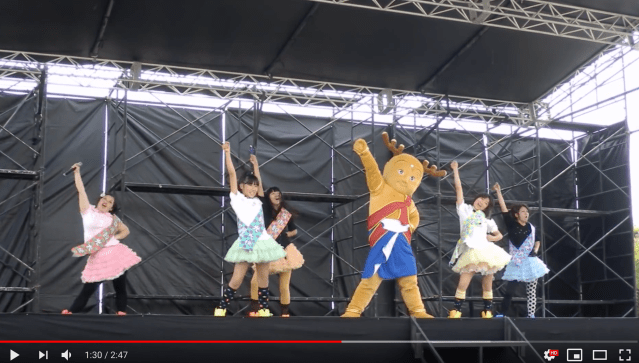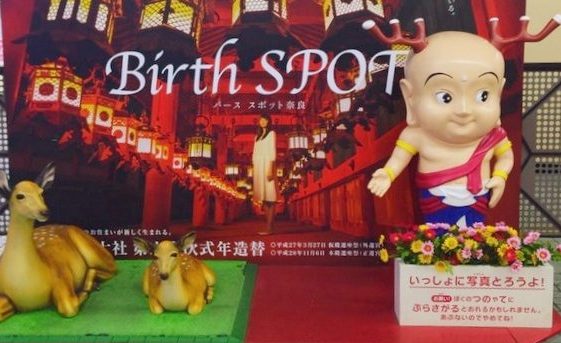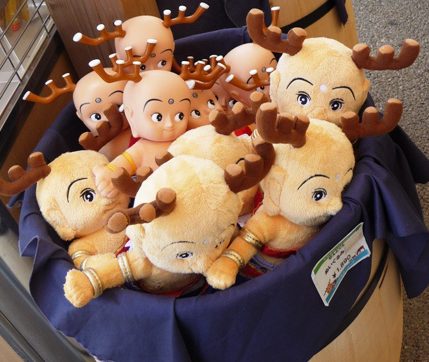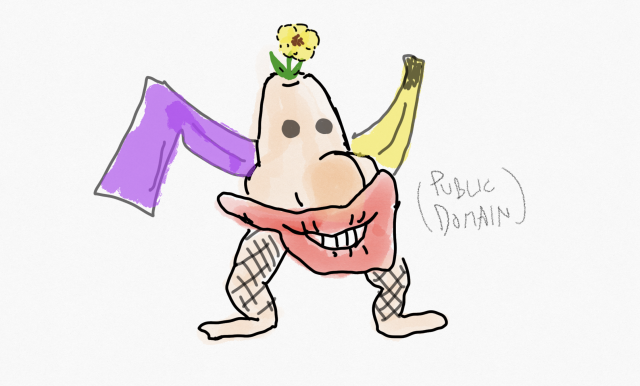
Savvy business practices helped the once-unsettling chimera win over hearts in the end.
Although not as prominent as its neighbor Kyoto, Nara is a hotbed of Japanese history, dating back even farther in time from its successor as the country’s capital, but still struggles to get the same level of fame. So, on 12 February 2008, the prefecture unveiled a new mascot to help drum up tourism: Sento-kun!
▼ Oh, here he comes now!
The concept was a combination of two of Nara’s most notable features: the courteous deer which roam freely in the city streets and the giant bronze statue of Buddha, both with a sprinkle of kawaii thrown in for good measure. However, what resulted was the abomination of half-measures seen above.
▼ Sento-kun (right) and a couple of deer (left)
Now, you might be thinking, “He…It’s not so bad looking,” and you’d be right, but you have to remember that this was back in 2008.
Times were a lot simpler then and people were demanded only the cutesiest in their regional mascots. The kimo-kawaii (disgusting-but-cute) wave of mascots, which Sento-kun’s notoriety likely helped trigger, wasn’t set to hit until a few years later. At the time of his debut, the Buddha-deer’s relative ugliness among its peers made headlines across the country.
At the same time, for many people Sento-kun was a breath of fresh air in the mascot world and it developed a cult following. So, Nara held onto him for various appearances and merchandising alongside other characters such as Shikamaro and Manto-kun that appealed to mainstream tastes. At its peak popularity in 2010, Sento-kun earned the city 49 million yen (US$450,000) in licensing revenue.
▼ And anyone would agree, “Sento-kun Dance” is one kickin’ ska tune
However, that well has since been gradually running drier. Sento-kun’s once unique style was overtaken by even more extreme mascots like Melon Guma and Floor Plan Boy. So, in August of 2018, Nara made the decision to make Sento-kun royalty free.
Following the policy of Kumamon, in which his likeness is free to use on the condition that it promotes his region of Kumamoto, this has been the Kumamon way since his beginning and has helped him become the undisputed king of mascots in Japan ever since.
It appears to be working for Sento-kun as well. Since adopting a looser copyright scheme, the number of groups applying for use of the mutant Buddha’s likeness spiked by 50 percent. In addition, according to a study by the Nihon Research Center last October, Sento-kun’s popularity among citizens aged 15 to 79 jumped by four points, putting it in third place behind stalwarts Kumamon and Funassyi.
It’s very strong evidence towards the benefits of a more relaxed copyright system, but that alone doesn’t equate guaranteed success. It takes the right set of circumstances and a well-oiled PR machine to make it work — just take my own copyright-free mascot Hananana-chan…
▼ …please.
While it doesn’t work for ever character, it’s nice to see Sento-kun get its due. Nara is a lovey place and well worth a visit. So, if you get a chance, stop by and check out all the historic sites and culture it has to offer. If you’re lucky you might even bump into Sento-kun in the felt. Just follow the sound of crying children.
Source: Sankei News
Top image: YouTube/manyufetty05
Photos © SoraNews24
● Want to hear about SoraNews24’s latest articles as soon as they’re published? Follow us on Facebook and Twitter!




 Thinking about moving to Nara? Here are eight things that may surprise you!
Thinking about moving to Nara? Here are eight things that may surprise you! New green tea Japanese Kit Kat released to raise funds for earthquake-damaged Kumamoto region
New green tea Japanese Kit Kat released to raise funds for earthquake-damaged Kumamoto region The poo from Nara Park’s deer is changing because of the coronavirus pandemic
The poo from Nara Park’s deer is changing because of the coronavirus pandemic Nara, Japanese city famous for its streets of tame deer, begins culling program within city
Nara, Japanese city famous for its streets of tame deer, begins culling program within city Kumamon and other Japanese mascots get muscular makeover in new energy drink commercial【Video】
Kumamon and other Japanese mascots get muscular makeover in new energy drink commercial【Video】 McDonald’s new Happy Meals offer up cute and practical Sanrio lifestyle goods
McDonald’s new Happy Meals offer up cute and practical Sanrio lifestyle goods All-you-can-drink Starbucks and amazing views part of Tokyo’s new 170 meter-high sky lounge
All-you-can-drink Starbucks and amazing views part of Tokyo’s new 170 meter-high sky lounge Studio Ghibli glasses cases let anime characters keep an eye on your spectacles
Studio Ghibli glasses cases let anime characters keep an eye on your spectacles Kyoto’s 100 Demons yokai monster parade returns!
Kyoto’s 100 Demons yokai monster parade returns! Super Nintendo World expansion gets delayed for several months at Universal Studios Japan
Super Nintendo World expansion gets delayed for several months at Universal Studios Japan Starbucks reopens at Shibuya Scramble Crossing with new look and design concept
Starbucks reopens at Shibuya Scramble Crossing with new look and design concept Beautiful Sailor Moon manhole cover coasters being given out for free by Tokyo tourist center
Beautiful Sailor Moon manhole cover coasters being given out for free by Tokyo tourist center Hamster abandoned at Tokyo ramen restaurant gets new home
Hamster abandoned at Tokyo ramen restaurant gets new home More foreign tourists than ever before in history visited Japan last month
More foreign tourists than ever before in history visited Japan last month The oldest tunnel in Japan is believed to be haunted, and strange things happen when we go there
The oldest tunnel in Japan is believed to be haunted, and strange things happen when we go there Disney princesses get official manga makeovers for Manga Princess Cafe opening in Tokyo
Disney princesses get official manga makeovers for Manga Princess Cafe opening in Tokyo Beautiful new Final Fantasy T-shirt collection on the way from Uniqlo【Photos】
Beautiful new Final Fantasy T-shirt collection on the way from Uniqlo【Photos】 Is the new Shinkansen Train Desk ticket worth it?
Is the new Shinkansen Train Desk ticket worth it? Foreign English teachers in Japan pick their favorite Japanese-language phrases【Survey】
Foreign English teachers in Japan pick their favorite Japanese-language phrases【Survey】 Japanese convenience store packs a whole bento into an onigiri rice ball
Japanese convenience store packs a whole bento into an onigiri rice ball We try out “Chan Ramen”, an underground type of ramen popular in the ramen community
We try out “Chan Ramen”, an underground type of ramen popular in the ramen community Studio Ghibli releases Kiki’s Delivery Service chocolate cake pouches in Japan
Studio Ghibli releases Kiki’s Delivery Service chocolate cake pouches in Japan Japan’s bone-breaking and record-breaking roller coaster is permanently shutting down
Japan’s bone-breaking and record-breaking roller coaster is permanently shutting down New definition of “Japanese whiskey” goes into effect to prevent fakes from fooling overseas buyers
New definition of “Japanese whiskey” goes into effect to prevent fakes from fooling overseas buyers Our Japanese reporter visits Costco in the U.S., finds super American and very Japanese things
Our Japanese reporter visits Costco in the U.S., finds super American and very Japanese things Studio Ghibli unveils Mother’s Day gift set that captures the love in My Neighbour Totoro
Studio Ghibli unveils Mother’s Day gift set that captures the love in My Neighbour Totoro Foreign passenger shoves conductor on one of the last full runs for Japan’s Thunderbird train
Foreign passenger shoves conductor on one of the last full runs for Japan’s Thunderbird train Domino’s Japan now sells…pizza ears?
Domino’s Japan now sells…pizza ears? New Japanese KitKat flavour stars Sanrio characters, including Hello Kitty
New Japanese KitKat flavour stars Sanrio characters, including Hello Kitty Kyoto creates new for-tourist buses to address overtourism with higher prices, faster rides
Kyoto creates new for-tourist buses to address overtourism with higher prices, faster rides Sales of Japan’s most convenient train ticket/shopping payment cards suspended indefinitely
Sales of Japan’s most convenient train ticket/shopping payment cards suspended indefinitely Sold-out Studio Ghibli desktop humidifiers are back so Totoro can help you through the dry season
Sold-out Studio Ghibli desktop humidifiers are back so Totoro can help you through the dry season Japanese government to make first change to romanization spelling rules since the 1950s
Japanese government to make first change to romanization spelling rules since the 1950s Ghibli founders Toshio Suzuki and Hayao Miyazaki contribute to Japanese whisky Totoro label design
Ghibli founders Toshio Suzuki and Hayao Miyazaki contribute to Japanese whisky Totoro label design Doraemon found buried at sea as scene from 1993 anime becomes real life【Photos】
Doraemon found buried at sea as scene from 1993 anime becomes real life【Photos】 Tokyo’s most famous Starbucks is closed
Tokyo’s most famous Starbucks is closed One Piece characters’ nationalities revealed, but fans have mixed opinions
One Piece characters’ nationalities revealed, but fans have mixed opinions We asked a Uniqlo employee what four things we should buy and their suggestions didn’t disappoint
We asked a Uniqlo employee what four things we should buy and their suggestions didn’t disappoint Princesses, fruits, and blacksmiths: Study reveals the 30 most unusual family names in Japan
Princesses, fruits, and blacksmiths: Study reveals the 30 most unusual family names in Japan Nara Park’s first baby deer of the year has been born, is totally adorable【Video】
Nara Park’s first baby deer of the year has been born, is totally adorable【Video】 Nara considering increasing number of deer that can be killed each year, expanding culling zone
Nara considering increasing number of deer that can be killed each year, expanding culling zone Nara deer leave park, head to station for food as tourist numbers tumble due to coronavirus
Nara deer leave park, head to station for food as tourist numbers tumble due to coronavirus Nara’s deer continue their summertime tradition of commandeering one of the city’s streets
Nara’s deer continue their summertime tradition of commandeering one of the city’s streets Deer killed by man with axe in Nara
Deer killed by man with axe in Nara Toyota goes full otaku, makes 40 kawaii mascots for every part of the car
Toyota goes full otaku, makes 40 kawaii mascots for every part of the car This year’s contest to choose Japan’s greatest mascot attracting some shady characters
This year’s contest to choose Japan’s greatest mascot attracting some shady characters Nara asks visitors to stop feeding the deer
Nara asks visitors to stop feeding the deer Adorable mascot bear Kumamon stars on the most popular new license plate in Japan
Adorable mascot bear Kumamon stars on the most popular new license plate in Japan Deer in Nara Park outnumber visitors, display baffling summer gathering behaviour
Deer in Nara Park outnumber visitors, display baffling summer gathering behaviour Deer in Nara Park mysteriously disappear during this year’s shikadamari season
Deer in Nara Park mysteriously disappear during this year’s shikadamari season Nara deer stampede into marathon, hit runner in their path
Nara deer stampede into marathon, hit runner in their path We really have a lot to learn from Japanese Mascot Character Parliament 【Video】
We really have a lot to learn from Japanese Mascot Character Parliament 【Video】 Nara unveils new vending machines that sell deer crackers
Nara unveils new vending machines that sell deer crackers Hearts are a-flutter over the handsome man behind Japanese city’s hero mascot【Photos】
Hearts are a-flutter over the handsome man behind Japanese city’s hero mascot【Photos】 Dress like an aristocrat from the Nara period at new costume rental shop in Nara【Photos】
Dress like an aristocrat from the Nara period at new costume rental shop in Nara【Photos】
Leave a Reply